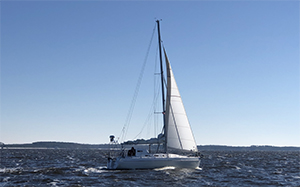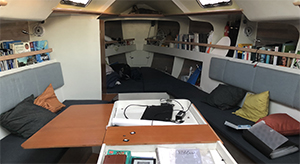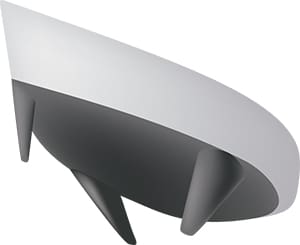To the editor: As ocean sailors, we meet some very interesting people — and Bart Pothoven from the Netherlands is no exception. I had the opportunity to spend four days sailing with Bart and his vessel Triakel. What really grabbed my attention about Bart was that he designed and built Triakel himself, and it has a novel underbody with three keels.
Bart started as an architect designing buildings. When the Americans lost the America’s Cup in 1983, many thought it was due to the secret winged keel. This keel was designed in the Netherlands. Bart was so impressed with this that he decided to see if he could improve on that design. After a number of years spent developing various designs in his spare time, he came up with the idea for the current design. Bart believed “lift of the keel should add to the righting moment of the vessel.” Another of Pothoven’s design goals was to improve speed and reduce leeway.
He presented his design idea to a number of Dutch naval architects, most of whom weren’t interested. He did get one of the country’s most respected designers, however, to say it was worth further study. With this recommendation, Bart’s proposal to the government was accepted and he was awarded funding for design, testing and prototype. By now, Bart had lost all interest in being an architect and devoted all his time to his keel design. He now had access to a top university and testing lab to help him refine his plans. After extensive calculations and testing in the towing tank at Delft University of Technology’s Ship Hydromechanics Laboratory, a special velocity prediction program (VPP) was developed. This was used to build the Triakel 18 prototype.
 |
|
Pothoven’s Triakel is equipped with the three-keel design. |
|
Ken Koehler |
The prototype showed some significant advantages over traditional designs. Bart said he was able to head downwind in Force 5 winds (17 to 21 knots), let go of the tiller and fill and light his pipe, and the boat held true to its course without any roll. This was due to the design of the keels counteracting one another. Other advantages the prototype showed included a reduced draft, all major forces remaining on the freeboard, and the ability for the boat to dry out sitting on its three keels. The prototype also proved the more beam the boat had, the more lift was created between the keels. This also showed that you could have a wide ship without the disadvantage of rolling when reaching or going off the wind.
Bart decided he would build a full-scale boat, renting a space in a large warehouse where he built the Triakel 34 out of wood. The hull is 0.787 inches thick, and the deck is 1 inch of glassed foam. As with the Triakel 18, the idea was to transfer the primary loads to the freeboard. With the absence of a central keel, the mast needed to be deck stepped. The mast sits on a bulkhead with two ridged poles transferring the compression load outboard to the freeboard. The keel struts are the entire freeboard. Each of the aft keels has 2,500 pounds of lead at the base, as well as a rudder incorporated in the trailing edge. Bart decided to utilize two electric motors with the shaft and prop just inboard of the aft keels, thus allowing thrust to pass over the rudders. These independent electric motors are operated by two joysticks and allow Triakel to turn in place. Bart stated that on a calm day, the boat can move sideways. These electric motors are powered by a 13.5-kW generator. The generator also helps charge the small house bank of batteries on those cloudy days when the solar panels aren’t as effective.
The interior is a spacious open-concept design. The molding and cushions are all on the same plane, contributing to the feeling of open space. The drawers and storage cabinets are efficiently designed and are very deep and secure. There are pictures of the construction of this wonderful boat on Bart’s website, www.triakel.nl. It took eight painstaking years to complete.
 |
|
The interior of Triakel. The full-size prototype is built primarily of wood. |
|
Ken Koehler |
Bart and I headed south for about four days together. Sailing side by side, off the wind with just our small headsails, I noticed how remarkably flat Triakel was sailing in the chop and wind. On our last day sailing together into Beaufort, N.C., we were sailing upwind and as the wind shifted I had to drop my sail and start to motor. Triakel continued to sail to within 30 degrees of the wind without signs of luffing. I was amazed how well she sailed and wouldn’t have believed it if I didn’t witness it myself.
A drawback with Bart’s Triakel design is that the lead at the base of the aft keels is prone to catching fishing lines and lobster traps. In the North Atlantic, before getting to Nova Scotia, Triakel was dismasted in a storm. Like a catamaran, without the ability to roll with the wind gusts, there is significantly more load put on the mast. With the forward keel, a hard tack needs to be done with the jib almost back-winded before coming around.
I left Triakel and Bart in Beaufort, N.C., where he provisioned and sailed to Bermuda.
—Ken Koehler is currently voyaging aboard his pilothouse Tayana 37 sloop, Surrender.

